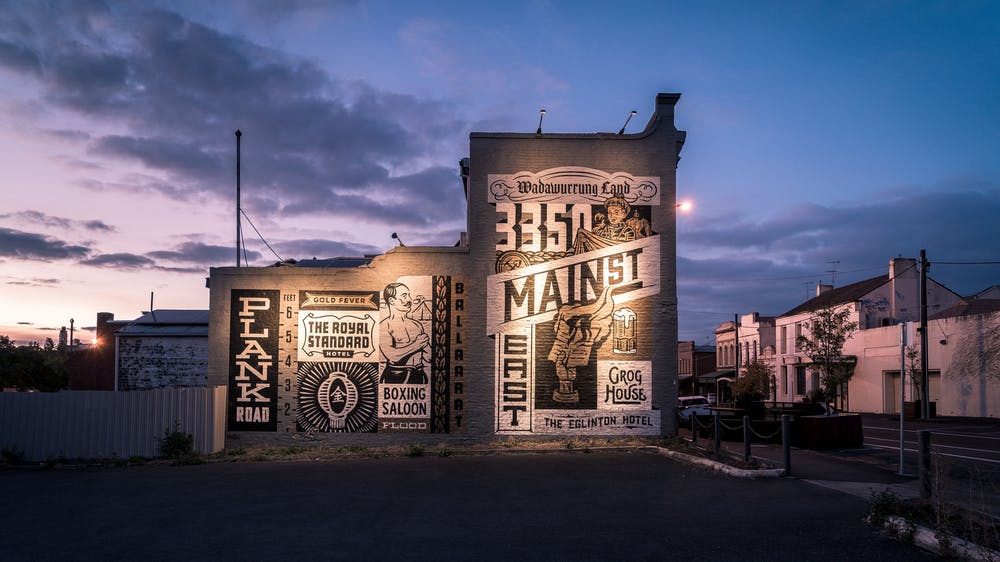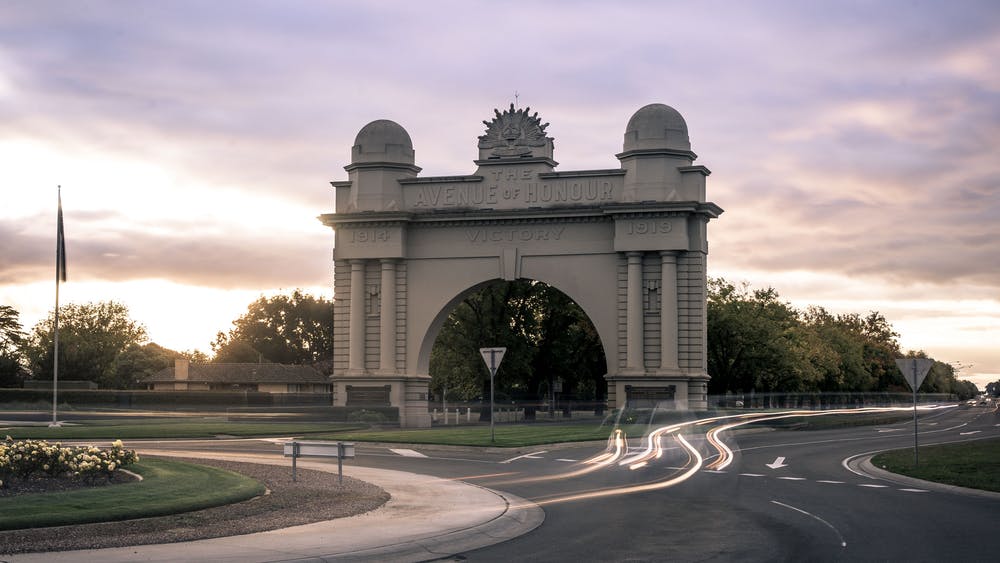Start typing to search
You can also hit “Enter” on your keyboard to submit your query.
0What's on
0Everything Else
Ballarat Public Art Walks: Sturt Street
Visit Ballarat
17 Oct 2022
Filed underSee & Do
This is one of four public art walks highlighting the City of Ballarat’s Public Art Collection.
The collection holds over 120 artworks and is one of the largest and most significant regional public art collections in Australia.
- Moderate walk, some inclines
- 1-1.5 hours
Petersen Fountain
1922
This fountain was created as the result of a bequest from Ballarat businessman Carsten Heinrich Petersen, who was killed at the age of 85 years when crossing Sturt Street opposite the Ballarat Base Hospital.
On the other side of the street were three brick shops which he owned.
George Treloar Memorial
Lis Johnson (2019)
This depiction of Major George Devine Treloar (1884-1980) by artist Lis Johnson was commissioned by the George Devine Treloar Memorial Committee and the City of Ballarat.
Treloar was appointed as the League of Nations Commissioner for Refugees in Greece in 1922 where he worked to provide food, aid and comfort to what would eventually total over 100,000 refugees from the collapsing Ottoman Empire.
Mother Earth
George Allan (1952)
Mother Earth is a moving tribute to nature’s gifts of mining and agriculture by recognised modernist sculptor George Allan.
Local resident Frank Pinkerton commissioned the work made from Hawkesbury freestone and granite.
Gordon Memorial
Raymond B. Ewers (1969)
The bronze statue of a horse commemorates poet and horseman Adam Lindsay Gordon and the horses and mules killed during WWI.
The statue depicts a horse going into battle known as a ‘charger’ mounted on a base of Warrenheip granite.
During World War II, the artist, Raymond Ewers, was made an official war artist with the rank of lieutenant.
Cenotaph
John B. Shimmin (architect)
The Ballarat Cenotaph commemorates those who died in service or were killed in action in WWI and WWI.
The cenotaph was unveiled by the Governor, Sir Dallas Brooks on 24 November 1949 in front of a crowd estimated to be between 3000 and 4000 people.
Eternal Flame
Peter Blizzard (1995)
Eternal Flame was created by renowned Ballarat sculptor Peter Blizzard as a marker of the end of WWII in the Pacific.
Engraved into the bluestone-shaped tile across the base of the statue is details about conflict areas where Australian troops were active.
The metal structure mimics a moving flame with its polished golden hue, a feature included in many war memorials around the world.
Peter Lalor
Thomas Nelson McLean (1883)
The Peter Lalor statue by Thomas Nelson McLean is said to be a striking likeness of Lalor who is remembered as the leader of the Eureka Rebellion.
The artist has depicted Lalor’s missing arm which he lost in the Rebellion efforts on 3 December 1854 and four bronze relief panels depict major events in Lalor’s life, including his involvement at Eureka and in Parliament, where he served as the Speaker of the House.
Korea, Malaya, Borneo, Vietnam
2000
‘Lest We Forget’ is a contemporary and crisp treatment, marking the sacrifices of Australian forces involved in the conflicts of south-east Asia, including the Korean War (1950-53), the Malayan Emergency (1950-60), the Borneo Uprising (1962-64) and the Vietnam War (1962-72).
A plaque was added in 2006 by the Victorian Vietnam Veterans Community.
Queen Alexandra Bandstand
1908
The heritage-listed Queen Alexandra Bandstand was the first of two bandstands to be erected in Ballarat.
Music motifs can be found throughout its fine wrought iron lacework.
This bandstand is a polygonal structure topped by a Moorish dome, typical of bandstand architecture of its time.
Albert Coates
Louis Laumen (2012)
Leading surgeon and academic Sir Albert Coates (1895-1977) is one of Ballarat’s most celebrated sons.
A medical orderly during WWI, he returned home to become a pioneering neurosurgeon.
A medical man in the worst of circumstances, Coates is often mentioned for his compassion and care in his role as a doctor in the Burma-Siam Railway Prisoner of War camps.
The bronze statue by Louis Lauman captures his down-to-earth nature.
Harold Pompey Elliott
Louis Laumen (2011)
Harold Edward ‘Pompey’ Elliot was first and foremost a soldier.
Schooled in Ballarat, he spoke often of his love of battle, and the sheer beauty of the fighting troops.
This contemporary bronze sculpture has detailed elements of the uniform and posture of the military of the time and stance of a man sure of his own strength.
William Dunstan VC Memorial
1995
The Dunstan Memorial is a minimal form of rough-cut bluestone and sheet granite in memory of Ballarat-born soldier, William Dunstan, who served with honour in Gallipoli.
His unit successfully defended a post despite being seriously wounded.
He and one mate were the only survivors of the 10 men defending the trench and all were awarded the Victoria Cross.
King George V Monument
Victor Greenhalgh (1938)
This bronze sculpture of King George V was created to commemorate the King’s 25th year on the throne.
It shows the King wearing the full robes of the Order of the Garter.
Sculptor Victor Greenhalgh modelled the artwork in Ballarat and sent in to Italy for casting in bronze.
Hebe & Ruth
Charles Summers (1899)
Hebe, Greek Goddess of Youth and the biblical figure Ruth, were the gift of wealthy local benefactor John Permewan, who owned carrier firm Permewan & Wright.
He commissioned Charles Summers to sculpt the iconic women figures.
Thomas Moore
John Udny (1889)
Irish poet and balladeer Thomas Moore was best known for penning The Minstrel Boy and The Last Rose of Summer.
Queen Victoria
Sir Bertram MacKennal (1897)
Queen Victoria continues to reign over Sturt Street through the work of Sir Bertram Mackennal.
The statue features four bronze scenes from her remarkable life – accession to the throne, her coronation, diamond jubilee and signing the Australian constitution.
Bertram Mackennal was the first Australian artist to be knighted.
Queen Victoria Fountain
1902
Ballarat’s Women’s Christian Temperance Union paid tribute with the Queen Victoria Fountain, 1902.
This much-loved fountain, with its marble children on a polished granite, was restored in 1976.
Boer War Memorial
James White (1906)
The Boer War Memorial was created by sculptor James White in honour of Australian soldiers who fought in the South African War (1899-1902).
White used the electrolytic copper deposit method to produce this large statue, which is sometimes mistaken for a cast bronze work.
Burke & Wills Fountain
1867
Ballarat son Robert O’Hara Burke and his good mate William John Wills are commemorated in the Burke & Wills Fountain.
This memorial to the famous explorers also features the names of those who assisted their ill-fated crossing of Australia.
The fountain was once lit with gas and stocked with goldfish and tortoises.
Robert Burns
John Udny
This is Australia’s first monument to the famous Scottish poet Robert Burns and his dog.
It was carved from marble in Italy by sculptor John Udny and is inscribed with quotes from the writer himself and features beautiful patterned tiles at its base.
Titanic Memorial Bandstand
1913
A year after the Titanic sunk, Ballarat sought to honour the bandsmen who lost their lives in the shipwreck.
The Titanic Memorial Bandstand commemorates the men who, legend states, continued to play for terrified guests as the ship went down.
Look for the unusual weathervane on the terracotta roof.
Point to Sky
Akio Makigawa (1999)
Completed posthumously, Point to Sky is one of Akio Makigawa’s last works.
It is the only public artwork by the celebrated Australian-Japanese sculptor in a regional city.
The top seed pod is gold, referencing Ballarat as the central gold rush town and the sun as the source of life.
The Pioneer Miner’s Monument
John Skilbeck – miniature poppet head creator (1951)
The Pioneer Miner’s Monument marks the very first finding of gold at Poverty Point in 1851.
The quartz structure features a replica of the 62.8kg Welcome Nugget, the world’s largest at the time, found in Ballarat in 1858.
The original was once displayed and local mothers would sit their babies on top for luck.
James Galloway Monument
1880
This quartz and bluestone monument pays tribute to James Galloway, the founder of the the eight-hour day system that gave workers the right to stop work after eight hours without any penalty.
The system was widely celebrated as a world first and Australia became known as a workingman’s paradise.




